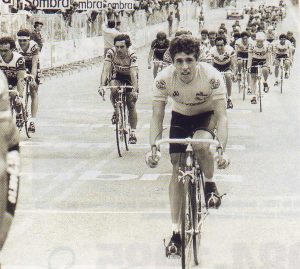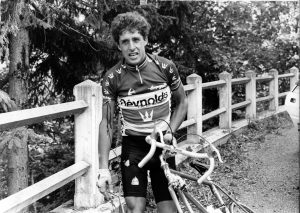1984. Reynolds. His first yelow jersey and the damn falls.
Pedro was by now a much valued rider and was well known internationally. The Tour of France had been an excellent showcase for demonstrating his abilities.
His results were nothing to write home about this season until the seventh stage of La Vuelta (a summit finish at Rasos de Peguera) where he came second behind Caritoux ….. and moved into the overall lead. He remained in yellow until the Lagos de Enol (12th stage), where, unable to keep up with the pace of his rivals, he was relegated to 3rd overall. «The Vuelta was by no means over and the time lost against the leader could be made up. It was the famous Tour of Caritoux and Alberto Fernández. I attacked on familiar territory and it wasn’t up but downhill. The race was dangerous because of the rain and I managed to increase the gap but behind me several teams rallied together against me and managed to catch me up before we got to Segovia. The next day was the last time trial which took place in Torrejón de Ardoz. It was 33 kms long and I had a minute to pull back. The first time references were good, better than my team-mate Gorospe’s (who won the time trial) but the rain, which again made its presence in this stage, together with my ambition, made me take more risks and so I fell. Funnily enough I crashed into a traffic sign.Nothing happened to me but from then on I was more careful in the time trial and I lost my third place.». It wasn’t to be! It just wasn’t my lucky day.
 |
| His first yelow jersey |
Pedro, who wasn’t superstitious, took no notice when he was given the number 13 to wear in his second Tour of France and went on to suffer an unimportant crash in the first stage. The days went by and on the 7th stage, a 67-km time trial; he went up 71 positions in the general classification to 25th place. The next day he was 4th in Nantes then 3rd in the Pyrenees stage, all of which placed him 9th in the overall. He was already 6th on the stage before the Alpe d’Huez but while he was riding towards the Col Alpino he lost more than 9 minutes and was relegated to 10th overall, more than 13 minutes down on Fignon. «I think I gave too much of myself in the first few kilometres of the stage, I felt really motivated, on the second mountain pass I pulled a bit away from the group and didn’t have enough time to recover on the descent and get back into the leading group. So I got to the foot of the Alpe d’Huez more than a minute and a half behind and from then on the ascent seemed eternal».
The next day, in the Plagne, Delgado was fourth and moved to 5th in the overall. He then began to compete for the mountain prize with Robert Millar. They continued their fight in the Alpes and in Morzine, his team-mate, Angel Arroyo, scored a brilliant stage victory. On the descent of the last mountain pass, Joux Plane, LeMond broke away like the wind, Delgado followed him and they manage to break away from Fignon, the leader.
Pedro dreamed of garnering the two first places of the day like in the Tour of the previous year, and began the descent at momentum speed. However, just as the descent was coming to an end he missed a bend and crashed against the side of a bridge. In spite of having broken his colour bone, he finished the stage as best he could. The next day he decided to drop out.
 |
| Tour de France, 1984. Descending from the Joux Plane, where he breaks his collarbone and is forced to quit. |
Pedro summed up the season of 1984:«the season has been positive. The only bad memories I have are of the two crashes in the Vuelta and Tour, which deprived me of two victories which I think I deserved».